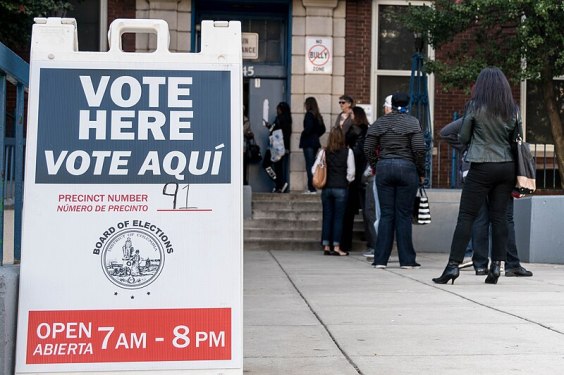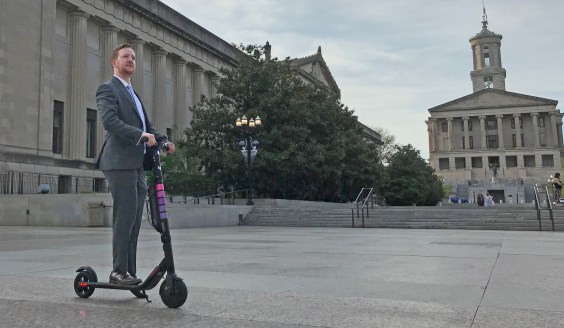Editor's note: Did we leave anything out? If so, please tell us about it in the comments below.
The California ballot is a long one this year. There are eleven state ballot measures, and hundreds of local elections will include their own measures. Many of these ask voters to approve bonds, parcel taxes, and sales taxes, some of them unspecified (for general funds) and some specifically for schools, public safety, city services, parks, and other uses. The long list of measures speaks to how strapped local governments are, especially when it comes to upkeep of school facilities.
About sixteen or so of the local measures on California ballots are aimed at raising money for transportation. Transportation funding measures, like all measures that apply to specific uses, can be difficult to pass, as they require at least a two-thirds majority vote. But the state encourages counties to do so by giving them access to additional state funding. There are 25 so-called "self-help counties" in California that have voted to tax themselves and are thus eligible to compete for those state funds.
Because they need to meet such a high vote threshold, transportation funding ballot measures tend to include broad lists of different types of projects - new roads, repaving and road maintenance, sometimes transit, bike, and pedestrian projects - in order to garner as broad a base of support as possible.
In contrast, general tax measures - that don't specify where funding goes - as well as citizen's initiatives only need a little over half of the vote. This has caused some interesting developments, as for example when San Francisco passed an unspecified general tax accompanied by a separate measure detailing how the money would be spent. Also see below, where in the city of Berkeley two different citizens initiatives are battling it out.
This would all change if Proposition 5, on the state ballot, passes. Prop 5 is a constitutional amendment that would lower the vote threshold to 55 percent for local bond measures that fund affordable housing and public infrastructure, defined as projects on water quality, sanitation, treatment of wastewater, protection of property from sea level rise, parks and recreation facilities, flood control, streets, highways, broadband internet access, local hospital construction, public safety buildings, and public libraries.
Berkeley's Dueling Transportation Measures
Here's a twist only a place like the city of Berkeley could come up with. To fight a transportation tax measure they don't like, an anti-tax group has proposed its own, less effective, tax measure. Both of the citizens' initiatives will be on Berkeley's ballot, and if both win, whichever gets the most votes will defeat the other.
Both would impose a parcel tax to pay for road repair, but that's where the resemblance between them ends. The original initiative written by a broad coalition of public groups, would raise more money and put more towards building out the city's planned bike and pedestrian network. The group was formed with city support in response to the failure of an earlier bond measure in 2022 that was meant to fund street repairs and build housing. A majority voted for that measure, but it needed two-thirds vote to pass. Thus the effort to create a citizens' initiative that would only need a majority vote to pass.
The group that authored the measure, Berkeley Citizens for Safer Streets, worked out compromises between advocates for safer streets and more bike and pedestrian infrastructure and others, including a group that had formed in order to oppose the original measure. The finished initiative, FF, included, for example, a prohibition on spending funds to build a bike lane on Hopkins Street, even though it is in the city's Bike Plan, because the controversy around those lanes riled up the city last year.
But after the compromises were reached, and the initiative was written, Berkeleyans for Better Planning - the group that opposed the first initiative - walked away. They wrote their own initiative, EE, which would raise far less money - barely enough to cover deferred maintenance on the city's streets. It allows "up to seven percent" of the funding to be used for "traffic calming measures on bicycle boulevards," but prohibits any spending on new infrastructure, including complete streets and bike lanes in the city's plans.
Darrel Owens wrote a fascinating post laying out the context giving rise to the battling initiatives and describing the way the forces for and against better streets and bikeways are playing out in Berkeley. He also describes the sort of status quo that would entrench itself if EE passes: the recent repaving of Rose Street, for example, left out safety improvements in the city's plans, leaving the street less safe than it was. Potholes at least tended to slow cars down, but the smooth pavement is allowing them to drive faster, even in front of several schools. "It’s the folly of not doing safety improvements with re-pavings: drivers get comfortable, speed more, and it is only a matter time until someone gets killed when we could’ve done it right the first time," he writes.
Other Local Tax Measures
San Diego County's ballot includes a citizens initiative that would raise a half-cent sales tax for transportation infrastructure. A city-led measure in 2016 was approved by 58 percent of voters, but not enough to pass. This measure goes strong on public transit: Half of it would be for public transit infrastructure, including a rail connection to the airport, a new rail line, new bus rapid transit routes, and safety upgrades. About a quarter would be for road and highway safety and maintenance, with other portions of the measure going for local streets and roads, public transit operations like increased bus frequency, and rail repairs.
Madera County already has a half-cent sales tax for streets and roads, passed in 1990. It continues until 2027, but an attempt to renew it in 2020 failed, and the pressure is on. A group calling itself Moving Madera Forward proposed a citizens' initiative and collected enough signatures to get it on the ballot, qualifying it to only need a simple majority vote.
The expenditure plan includes $352 million for local streets and roads, with about ten percent of that meant for disadvantaged communities. Another $64 million would go towards regional projects included in the county's Regional Transportation Plan (RTP), including some wildfire evacuation routes and widening Highway 41.
Four percent of the revenue ($17.6 million) would be for public transit operations, maintenance, and improvements.
Some residents oppose it, saying it does not set strict enough rules for how local street and road funding can be used, and does not precisely define what qualifies as a disadvantaged community. They say it is important to get the spending plan right before passing a measure that will dictate transportation spending for the next several decades.
Placer County aims to become a new self-help region with another try at a thirty-year, 1/2 cent sales tax in the cities of Roseville, Rocklin, and Lincoln. The funding would be used to widen State Route 65 from three to five lanes in each direction between Galleria Boulevard and Twelve Bridges Road and to widen the interchange at Interstate 80 and State Route 65. Some of it would go towards local road improvements such as pothole repair and repaving, with a smaller percentage for local transit systems and bicycle and pedestrian pathway projects.
Amador County will vote on a 0.75% sales tax measure on transactions "in the unincorporated parts of the county" for repair, maintenance and improvement of local county roads.
Napa County voters will weigh in on whether to renew an existing half-cent sales tax for road repairs, transit, and bike and pedestrian safety.
The city of Santa Fe Springs has a measure on its local ballot to impose an annual parcel tax of 7 cents per square foot on commercial lots and 3½ cents per square foot on industrial and vacant lots, to be used for road repair.
The city of Albany will vote on whether to renew an existing parcel tax dedicated to sidewalk repair.
The city of Hayward will decide whether to extend an existing half-cent sales tax for "essential services" that include emergency response, police, street repairs, and "facility modernization."
The Middle River Community Services district in Calaveras County will consider increasing an existing parcel tax for road maintenance.
Voters in Williams, in Colusa County, will consider whether to double an existing sales tax measure to one percent, to be used for road repairs (eighty percent), parks and recreation (ten percent), and fire protection services (ten percent).
Fairfax voters will decide whether to authorize an $18 million bond for "road and infrastructure repairs, including potholes, street repaving, bridges, and flooding issues, and to improve bike/pedestrian circulation, safe routes to schools, and disabled access, as well as to qualify for federal matching funds/grants."
The city of Benicia is considering a measure that authorizes a new half-cent sales tax for "repairing, maintaining, and improving Benicia's streets, roads, potholes and related sidewalks and storm drains."
Beyers Lane Community Service District in Nevada County has a ballot measure to renew an annual parcel tax that pays for "necessary road and culvert maintenance."
The city of Red Bluff in Tehama County is considering a new 3/4 cent sales tax to "fix potholes, maintain and repair deteriorating local streets and roads, reduce expensive future repairs, improve safety for drivers, pedestrians, disabled residents, including safe routes to children’s school, and make the City eligible for state and federal matching funds."
Two Other Ballot Measures of Note
These two measures are not sales or parcel taxes, but they affect transportation:
City of Santa Monica voters will decide whether to increase the tax on privately-owned parking lots from ten percent to eighteen percent. City-owned lots would still tax parking at ten percent. This would be a general tax, so could pass with a simple majority of support.
Voters in Cotati are considering a measure to repeal a prohibition on the construction of roundabouts, traffic circles, and similar traffic features within city limits. That prohibition was passed by majority vote in 2012, and it killed a long-planned project that would have narrowed Old Redwood Highway through Cotati's commercial center.






